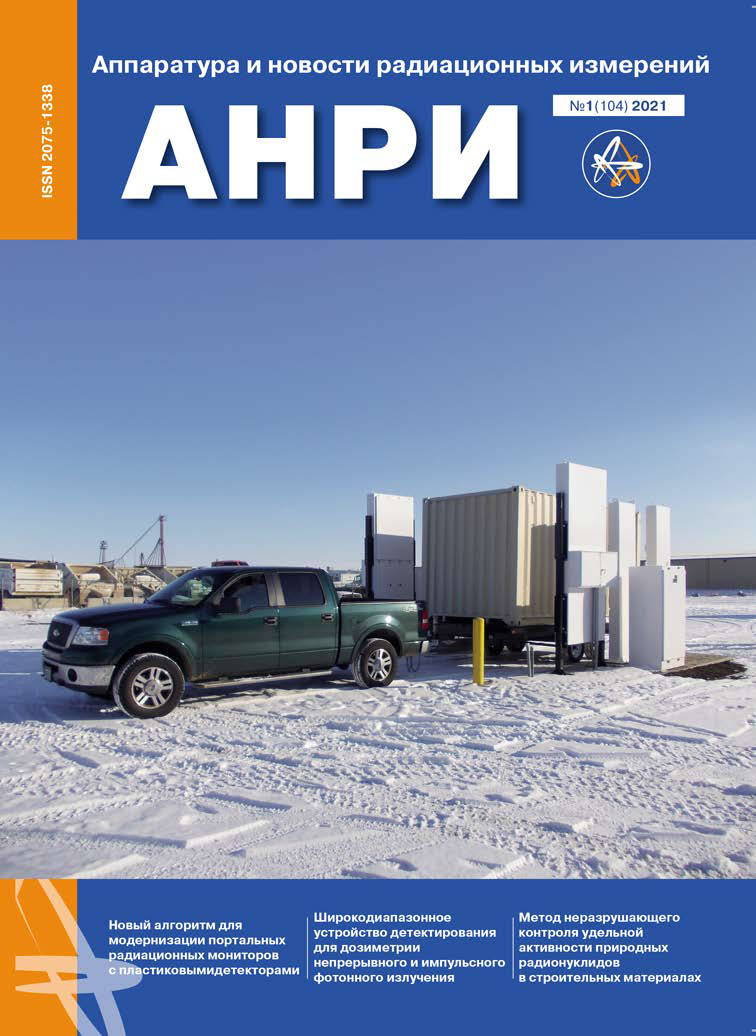Russian Federation
Ural Federal University
A method for non-destructive monitoring of the content of natural radionuclides in building materials has been developed. Spectrum measurements of gamma radiation are carried out with a pre-calibrated field gamma spectrometer. The calculation of the average specific activity of natural radionuclides in building materials is carried out by comparing the calculated flux density of unscattered gamma quanta normalized to the specific activity, and the experimentally measured count rates in the photopeak. calculated for the geometry of the room under study and the location of the detector. Application of the developed method makes it possible to estimate the average activity of natural radionuclides in building materials without destruction.
natural radionuclides, building materials, radon study, radium
1. UNSCEAR 2006. Sources and Effects of Ionizing Radiation. United Nations Scientific Committee on the Effects of Atomic Radiation. New York: United Nations, 2006.
2. A.V. Nero, W.W. Nazaroff. Characterizing the Source of Radon Indoors//Radiat. Prot. Dosim., vol. 7, pp. 23-39, 1984. URL: https://doi.org/10.1093/oxfordjournals.rpd.a082958 (data obrascheniya: 18.12.2020).
3. W.W. Nazaroff, “Entry by pressure-driven flow or molecular diffusion? A reassessment of 222Rn concentrations measured in an energy efficient house”, Health Phys. vol. 55, pp. 1005-1009, 1988.
4. H. Arvela, “Seasonal Variation in radon concentration of 3000 dwellings with model comparisons”, Radiat. Protect. Dosim., vol. 59, no. 1, pp. 33-42, 1995. URL: https://doi.org/10.1093/oxfordjournals.rpd.a082634 (data obrascheniya: 18.12.2020).
5. European Collaborative Action “Indoor Air Quality and its Impact on Man”, “Radon in indoor air”. Report no. 15, EUR 161 23 EN, 1995. URL: http://www.inive.org/medias/ECA/ECA_Report15.pdf (data obrascheniya 03.01.2021).
6. B. Levesque, D. Gauvin, R.G. McGregor et al., “Radon in residences: influences of geological and housing characteristics”, Health Phys., vol. 72, pp. 907-914, 1997. URL: https://doi.org/10.1097/00004032-199706000-00009 (data obrascheniya: 18.12.2020).
7. ICRP. Protection Against Radon-222 at Home and at Work. ICRP Publication 65. Ann. ICRP, vol. 23, no. 2, 1993.
8. G.A. Swedjemark, “Radioactivity in houses built of aerated concrete based on alum shale”. Specialist meeting on the assessment of radon and daughter exposure and related biological effects. Rome, 3-8 March, 1980. URL: https://inis.iaea.org/collection/NCLCollectionStore/_Public/11/555/11555044.pdf?r=1 (data obrascheniya: 03.01.2021).
9. G.A. Swedjemark, “The history of radon from a Swedish perspective”, Radiat. Protect. Dosim., vol. 109, no. 4, pp. 421-426, 2004. URL: https://doi.org/10.1093/rpd/nch318 (data obrascheniya: 03.01.2021).
10. J. Hulka, J. Vlcek and J. Thomas, “Natural radioactivity in building materials - Czech experience and European legislation”. Proceedings of the American Association of Radon Scientists and Technologists 2008 International Symposium Las Vegas NV, September 14-17, pp. 1-8, 2008. URL: http://citeseerx.ist.psu.edu/viewdoc/download?doi=10.1.1.371.4443&rep=rep1&type=pdf (data obrascheniya: 03.01.2021).
11. J. Thomas, “Prehistory of the Czech radon program”, Radiat. Protect. Dosim., vol. 191, no. 2, pp. 121-124, 2020. URL: https://doi.org/doihttps://doi.org/10.1093/rpd/ncaa164 (data obrascheniya: 03.01.2021).
12. A.V. Vasilyev and M.V. Zhukovsky, “Determination of mechanisms and parameters which affect radon entry into a room”, J. Environ. Radioact., vol. 124, pp. 185-190, 2013. URL: http://dx.doi.org/10.1016/j.jenvrad.2013.04.014 (data obrascheniya: 03.01.2021).
13. I.V. Yarmoshenko, A.D. Onishchenko, G.P. Malinovsky, A.V. Vasilyev, E.I. Nazarov and M.V. Zhukovsky, “Radon concentration in conventional and new energy efficient multi-storey apartment houses: results of survey in four Russian cities”, Sci. Rep. vol. 10, article 18136, 2020. URL: https://doi.org/10.1038/s41598-020-75274-4 (data obrascheniya: 03.01.2021).
14. M.V. Zhukovsky and A.V.Vasilyev, “Mechanisms and sources of radon entry in buildings constructed with modern technologies”, Radiat. Protect. Dosim., vol. 160, no. 1-3, pp. 48-52, 2014. URL: https://doi.org/10.1093/rpd/ncu111 (data obrascheniya: 03.01.2021).
15. I.V. Yarmoshenko, A.V. Vasilyev, A.D. Onishchenko, S.M. Kiselev, and M.V. Zhukovsky, “Indoor radon problem in energy efficient multi-storey buildings”, Radiat. Protect. Dosim., vol. 160, no. 1-3, pp. 53-56, 2014. URL: https://doi.org/10.1093/rpd/ncu110 (data obrascheniya: 03.01.2021).
16. A.V. Vasilyev, I.V. Yarmoshenko and M.V. Zhukovsky, “Low air exchange rate causes high indoor radon concentration in energy-efficient buildings”, Radiat. Protect. Dosim., vol. 164, no. 4, pp. 601-605, 2015. URL: https://doi.org/doihttps://doi.org/10.1093/rpd/ncv319 (data obrascheniya: 03.01.2021).
17. ATOMTECH, Instruments and technologies for nuclear measurements and radiation monitoring. Product Catalogue, 2020. URL: ftp://ftp.atomtex.com/catalogues/catalogue_en.pdf (data obrascheniya: 03.01.2021).
18. Mostafa M.Yu., Zhukovskiy M.V., Vasyanovich M.E. Prototip pervichnogo etalona ob'emnoy aktivnosti radona//ANRI. 2017. N 3(90). C. 2-15.
19. Grove Software, MicroShield® User’s Manual. Grove Software, Division of Grove Engineering, Inc., 2017.
20. C. Yu, D.J. LePoire, J.-J. Cheng et al. User’s Manual for RESRAD-BUILD Ver. 3. ANL/EAD/03-1. Argonne, Illinois: Argonne National Laboratory, 2003.
21. Treyger S.I., Piskunov L.I., Smirnov B.P. Estestvennaya radioaktivnost' stroitel'nyh materialov na Srednem Urale. Sverdlovsk: PGO Uralgeologiya, 1987. 52 s.
22. M. Culot, H. Olson and K. Schiager, “Effective diffusion coefficient of radon in concrete, theory and method for field measurements”, Health Phys., vol. 30, pp. 263-270, 1976.
23. C. Nuccetelli, F. Leonardi and R. Trevisi, “Building material radon emanation and exhalation rate: Need of a shared measurement protocol from the European database analysis”, J. Environ. Radioact., vol. 225, article 106438, 2020. URL: https://doi.org/10.1016/j.jenvrad.2020.106438 (data obrascheniya: 03.01.2021).
24. R. Chauhan and A. Kumar, “A Comparative study of indoor radon contributed by diffusive and advective transport through intact concrete”, Physics Procedia, vol. 80, pp. 109-112, 2015. URL: https://doi.org/10.1016/j.phpro.2015.11.066 (data obrascheniya: 03.01.2021).
25. V.C. Rogers, K.K. Nielson and R.B. Holt, “Radon diffusion coefficients for aged residential concretes”, Health Phys., vol. 68, pp. 832-834, 1995. URL: https://doi.org/10.1016/10.1097/00004032-199506000-00011 (data obrascheniya: 03.01.2021).








